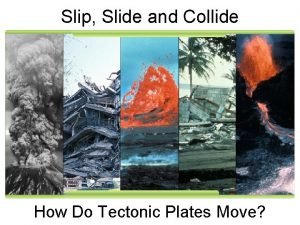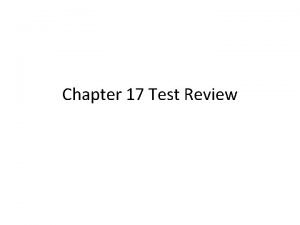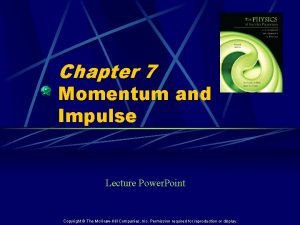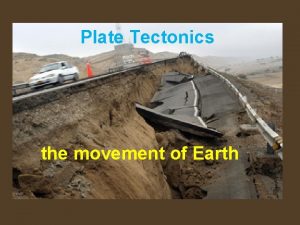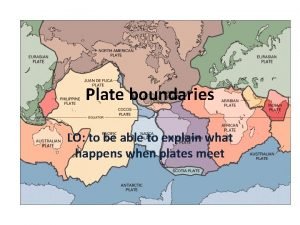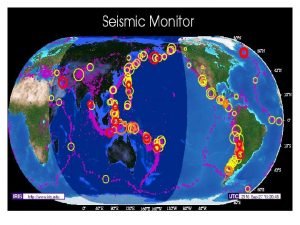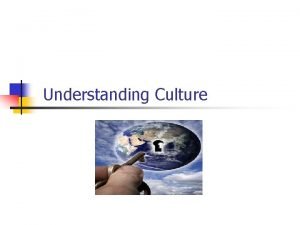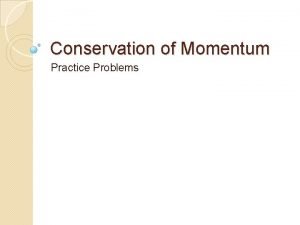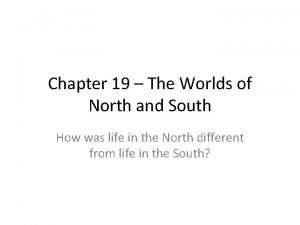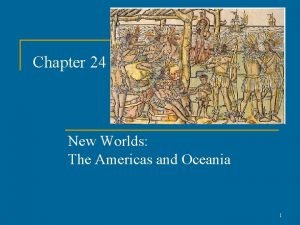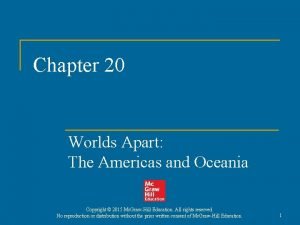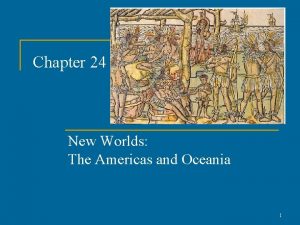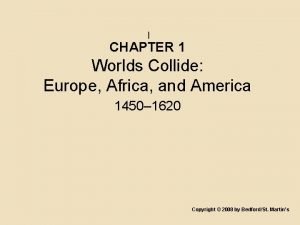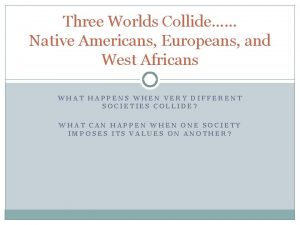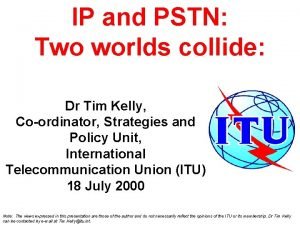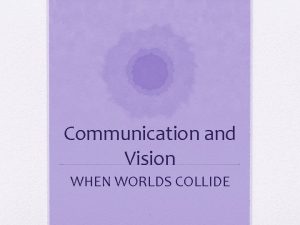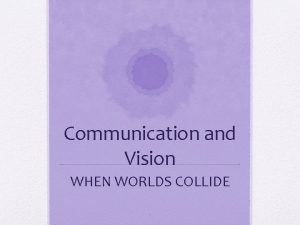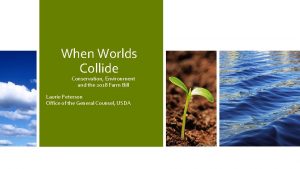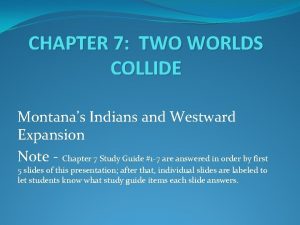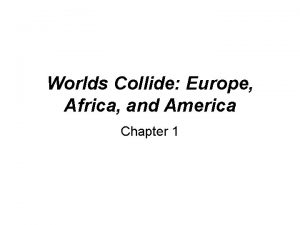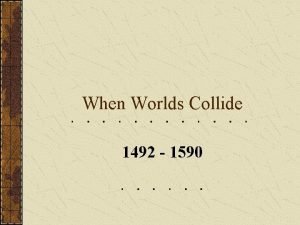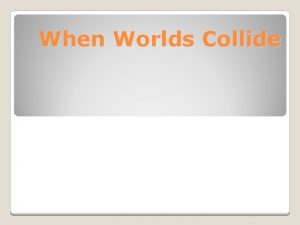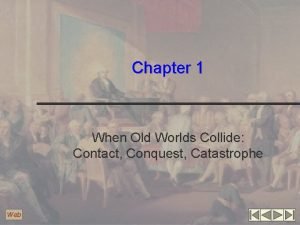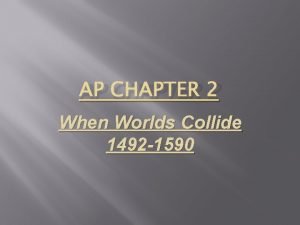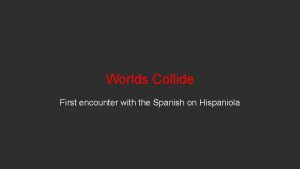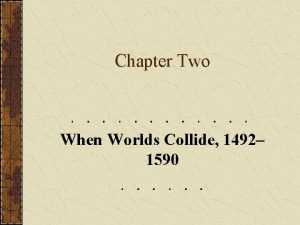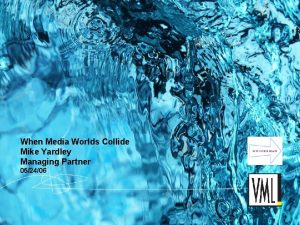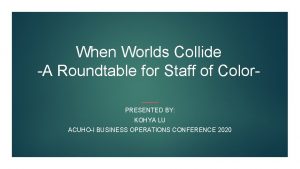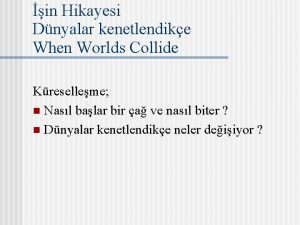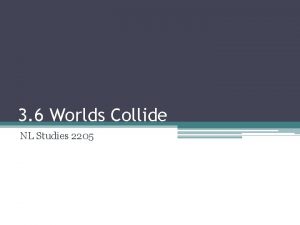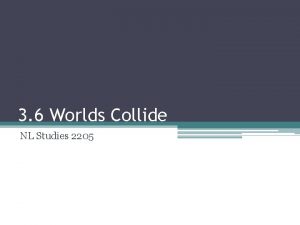How did the Worlds Collide When and where













































- Slides: 45

How did the Worlds Collide? When and where the first trips to Latin America? Source: Bergman and Renwick, 2003



COT Continuities Changes Farming Building infrastructure Trade Religious ideas still permeated (saints and deities intertwined) Mix of indigenous and Christianity (Voodoo, Santeria) Social hierarchies Warfare Mita system Tribute system Indigenous languages Native survivors provided similar labor and tracked the lay of the land many served as interpreters Great Dying (diseases) European voluntary migration African forced migration Viceroyalties ( colonial governments) Spanish language and religion (Roman Catholicism) Introduction of new foodstuffs ( pigs, sheep , chickens, cows, wheat, grain) Deforestation to leave room for grazing and crops Las castas racial based society (Peninsulares, Creoles, Mestizoes, Mullatoes, Natiive, African) Introduction of new skills and literacy European style cities (ex. Lima) Building of Missions and Universities Horse would change culture of Americas Stable food supplies

How did the Worlds Collide? When and where the first trips to Latin America? 1492 -1493 -1496 1502 -1504 1498 -1500

Spanish Empire in the Americas When and where the first viceroyalties and cities were established? http: //www. u-s-history. com/pages/h 1148. html

Treaty of Tordesillas-1494 Why is it so important? http: //www. harpercollege. edu/mhealy/geogres/maps/smgif/smtorde. gif

The Columbian Exchange • “The Columbian Exchange” is the sharing of cultures that transformed the lives of two continents. • Its was a two-way process with people, goods, and ideas moving back and forth. • The three G’s • What was exchanged? • • • Plants Animals Diseases Demographic Mineral Wealth Trade Items Technology Language Religion Economy Government Urban Planning

Plants Americas Europe • • • • Maize Potato Tomato Tobacco Beans Cacao Cotton Sugar Rice Wheat Coffee Banana Grapes

Origin of Plants and Livestock Source: Bergman and Renwick, 2003

Plants So what? • Asian and African plants were introduced such as bananas, plantains, sugarcane, and rice. • Crops were introduced to a new environment to which they were better suited and to a location that could easily be transported. • The Portuguese made it a policy to introduce plants from one part to another in their empire. Bananas to Brazil and maize, manioc, and peanuts to Africa. • These crops became important global commodities. • Diffusion of plants throughout the world.

Diffusion of Plants

Diffusion of Plants

Animals Americas Europe • Turkey • • Cattle Horse Pigs Sheep

Animals • Introduction of Animals from Europe had a big impact on land use, economies and lifestyles. • L. A. had no large domesticated animals except for llamas. • The imported animals became the center of Latin America livestock industry. • Environmental impact.

Diseases Americas Europe • New strains of syphilis • • Smallpox Flu Measles Typhus

Diseases “The greatest genocide in human history. ” • Central Mexico: – Indigenous population decline from 25 million to less than one million with a century. Mexico and Central America experienced a population decline by as much as 90 percent. • Caribbean: – In the island of Hispaniola, population declined from one million to 1492 to 46, 000 by 1512. • North America – 90 percent of the Indian population were gone within a century of the Puritan landing on Plymouth Rock.

Demographics of the Columbian Exchange 1) Indian population decrease 2) African Diaspora 3) European Migration 4) Mixing of Populations (miscegenation)

Animals

Indian Population Decrease • Diseases: – In Europe, an outbreak of small pox would kill 30 percent of those infected. – However, in the Americas the small pox death rate was nearly 50 percent. • War: – The battle of Tenochtitlan lasted eight days where 240, 000 natives perished. • Labor: 11 -12 million African captured by West African Kingdoms like Songhai, Asante, Dahomey and the Kongo

African Diaspora • A decrease in Native American population prompted labor import from Africa. • They worked in: – mines, – agriculture, – port towns, – sugar mills. • African slaves were imported to all parts of America. They were traded for rum, guns and molasses along West Africa trading ports

African Diaspora Source: Bergman and Renwick, 2003

European Migration • A relatively small number of European males migrated to Latin America and the Caribbean during the colonial period. • To give an example, from Mexico and Central America in 1570 only about 60, 000 or 2 percent of the total population 3, 096, 000, was classified as white. • By 1650 that white population had doubled to 120, 000, roughly 6 percent of the depleted total of 1, 880, 000. • At the close of the colonial era in 1825 about 1 million or 14 percent of the total population of just over 7 million was white.

European Migration 1800’s Source: Bergman and Renwick, 2003

Miscegenation • The intermixing of Indians, Africans, and Europeans created a multiracial society. • Color became status symbol. • Complex race structure. – Peninsulars: Europeans born in the Iberian Peninsula. – Creoles: Children of European descent born in America. – Mestizo: Offspring of European and Indian unions. – Mulatto: Children of European and African unions. – Zambos: Indians and Black. – Coyotes: Mestizos and Indian…. .

Religion • Religious Proclamation: English crown- ordered their agents to “conquer, occupy and possess” the lands of the “heathens and infidels. ” Spanish crown- sought not only to grab the land but to convert any indigenous people to “embrace the Catholic faith and be trained in good morals. ” (by any means necessary) Governors- Diego Velasquez, the Cuban governor instructed Hernan Cortez as he departed to Mexico in 1519, “Bear in mind from the beginning that the first aim of your expedition is to serve God and spread the Christian Faith. . . You must neglect no opportunity to spread the knowledge of the True Faith and the Church of God among those people who dwell in darkness”

Diffusion of Religion Source: Getis, and Fellman, 2005

Religion Results: • Baptism- within a month of Hernan Cortez arriving in Mexico first baptisms took place. • Consensual Unions/Marriages- newly baptized Indian women were grabbed as concubines. – Marriages were performed by priests. • Destruction- The first bishop of Mexico, Juan de Zumarraga, claimed to have destroyed more than five hundred Indigenous temples and twenty thousands idols. – In essence, the Spanish conquest of 1519 -1521 destroyed the core of Aztec religion—the cult of warfare and human sacrifice.

Religion • Transformation- The result of two strong religions was that old god went underground, and the Indians learned to cloak their worship in a Christian disguise. – Virgin of Guadalupe: the Virgin of Guadalupe appeared to an Aztec man named Juan Diego. Within six years 9 million Indians had been baptized as Catholics in central Mexico. – The Basilica of Our Lady of Guadalupe – Christians lyrics were written to Indian melodies and native dances were incorporated into Catholic morality plays. – The church accepted a process of mutual adaptation, in which Indians embraced Christianity symbols and forms, while the church turned a blind eye to the pagan content beneath the Catholic surface.

Religion • The Spanish missionaries early adopted the myth of Quetzalcoatl and thought that he was actually St. Thomas the Apostle, who had come to Mexico to help convert the Aztec Indians to Christianity and that the spirit of St. Thomas was in Cortes. • Jesuits encouraged adaptation of African deities, filled the church with black figures, created Christian rituals in African languages, music, and dances in order to reach the slaves. http: //www. crystalinks. com/aztecgods. html

Religion The Church reached every aspect of colonial life. • Administrative center- Functioned next to or above the Spanish Civil Government. • Financial center- while the crown collected its royal fifth from the elite, the church collected 10 percent from everyone. – Large landowner and had large labor force. • Revolutionary figures- Father Miguel Hidalgo, a Creole priest, organized an uprising of Mestizos and Indians. http: //www. mexconnect. com/mex_/images/virgin. jpg • Religious symbols- Virgin of Guadalupe

COT Americas 1450 -1750 • From 1450 -1750 European mercantilism and the exploitation of the land ( resources) labor (indigenous and African) and capital ( markets) created a new racialized society referred to as the las castas society (as evidenced by the encomienda system) , facilitated by the demographic shift due to the labor scarcity brought about by the great dying, however many native farming techniques and labor systems (mita) would persist. • 1450 -1750 would see a vast decline in native populations due to lack of immunity to “old world” diseases like small pox, however, the need to provide sustenance through agriculture and trade would continue as would the inability for Europeans to expand into the vast rainforests and high mountain ranges where indigenous populations would maintain their culture and way of life free from interference from foreign rule.

From 1450 -1750 European mercantilism and the exploitation of the land ( resources) labor (indigenous and African) and capital ( markets) created a new racialized society referred to as the las castas society (as evidenced by the encomienda system) , facilitated by the demographic shift due to the labor scarcity brought about by the great dying, however many native farming techniques and labor systems (mita) would persist The intermixing of races (miscegenation) created a new social hierarchy in the Americas of peninsulares, creoles, mestizos and mullatoes facilitating a rigid social order European mercantilism would create a new method of land, labor and capital exploitation for the purpose of creating a favorable balance of trade extracting resources only to sell back at a profit. The pre-existing Inca mita system would continue in the Andean plain for the purpose of regulating a labor force for resources Reinforced by both the viceroyalty government and the church, the system rewarded those with the strongest ties to Iberia and racially marginalized those based on the darkness of their skin. New colonies in the Americas were there to serve their colonizer signing agreements controlled by the crown to serve as a means of maximizing the amount of revenue. The vertical economy of the Andes and their infrastructure would serve the Spanish well to regulate a labor force familiar with the land its resource extraction.

Religion Source: Bergman and Renwick, 2003

Religion The importance of the Missions: • The church sent an army of Franciscan, Dominican, and Jesuits priests to the new territories. • Missionaries sought to escape the moral decay of Europe and save the lost souls of the Americas. • Missions became the principal frontier for the Spanish expansion. • The first mission was founded in Venezuela in 1520. • Tension arose between missions and landowners. – In 1767, the colonial elite succeeded in expelling the Jesuits. At that time 2, 200 Jesuits were working in the colonies with more than 700, 000 living in the missions.

Religion • Missions played a key role in colonizing the United States. – Franciscans founded 40 thriving missions in Florida and the Southwest. – Founders of key USA cities such as San Antonio, El Paso, Santa Fe, Tucson, San Diego, Los Angeles, Monterrey, and San Francisco. • Acculturation Center- agricultural practices, cultural, and religious.

Fig. 7. 25 Religion Source: Getis, and Fellman, 2005

Language Source: Bergman and Renwick, 2003

Trade Items Americas • Minerals Europe • Manufactured goods • Raw Materials • Agricultural products Mercantilism- using colonies as sources of raw materials and Markets for finished products

North/Latin America Colonization • • North American Charters of Joint Stock Co Mostly Protestant Laws forbidding intermarriage of race • Family colonization • Heavily private financing • Both: Christian/Ethnocentric/Co mpetitive/Racist/Reformati • • Latin American Royal Patronage Predominantly Catholic Miscegenation(Castas System) • Mostly European Males • Exploitative (Labor/Natural resources)

Summary of the Legacy of Colonization What you think is the legacy of colonization? • Political-audiencia became centers of newly independent states in Spanish America, so the colonial legal and administrative structure influenced state formation. • Architecture/Urban planning- The use of architecture and urban planning as tools of European conquest is a recurrent theme in Latin American history. King Philip II of Spain ordered town planners to use a grid or checkerboard plan for the layout of new towns and cities in his “Laws of the Indies” (1573). The plan featured a plaza major, or central square, with the main church, government buildings, and residences of the authorities facing the square. In port cities straight streets connected the plaza major to the warehouses and docks of the port and to the imposing fortresses that protected them.

Summary of the Legacy of Colonization • Social- a social class was created based on color, class, and culture. • Religion- a blending of religion occurred. - The church became an important power. • Language • Demographic-

Summary of the Legacy of Colonization • Economic- colonial Latin America produced primary products and was dependent on the Iberian Peninsula for markets, capital, and credit • Land ownership- the colonial era saw the development of large landowners at the top of the hierarchy. – Many landless peasants at the bottom. – Unequal distribution of land, resources, and wealth continued into the independence era. – The gap between rich and poor. • Gender relation-

Vocabulary Europe Africa Latin America North America Asia Mercantilism Christianity Protestant Caravels Prince Henry Alternative trade route Indentured servants Gold Commercial Revolution Bourgeoisie Absolute monarchs Urban centers Manufactured products Limited monarchies (constitutional) Renaissance Age of exploration Reformation Religious intolerance New world foodstuffs Universities Jesuits What goes on in Europe… Islam Christianity Chattel slavery Cassava and Sweet potato Dahomey Kongo ( King Alfonso and Queen Ndzinga) Benin Ife Civil War Firearms Molasses Rum Diplomacy Portuguese trade ports Bight of Benin Middle Passage Triangle Trade Slave ships Great Circuit Animism 10 -14 million enslaved Intensive labor Encomienda Repartamiento Sugar Silver Las castas system Viceroyalties New Granada, New Spain, New Castile Jesuits Mita Audiencia God, Gold and Glory Peninsulares Creoles Mestizos Mullatoes Native African European urban centers Horses, guns, wheat, chickens Deforestation Catholicism Universities Columbus, Cortez, Pizzaro Treaty of Tordesilla North American Charters of Joint Stock Co Mostly Protestant Laws forbidding intermarriage of race Family colonization Heavily private financing Families settling Virginia joint stock Co Dutch West Indian Co Massachusetts Bay Co Indian wars Pilgrims New Amsterdam New England New France Fur Timber Fish Rough winters Mercantilism Royal patronage Silver Manila Galleons Luxury products Sweet potato Coastal trading ports Jesuits Australia (not Asia I know) Philippines (Spanish Colony) Treaty of Tordesilla Indonesia (Dutch colony) Spices Sugar Las castas system in colonies Portuguese and Dutch then English and French Isolation of China and Japan Ottoman and Safavid blocking trade along Mediterranean and Silk Rotes

Further Reading • Schwarts, Stuart B. (1985) Sugar plantations in the formation of Brazilian society: Bahia 1550 -1835. • Clayton, Lawerence A. and Conniff, Michael L. (1999). A history of Latin America. • Winn, Peter (1992). Americas: The changing face of Latin America and the Caribbean. • Blouet, Brian W. and Blouet, Olwyn M. (2002). Latin America and the Caribbean: A systematic and regional survey.
 Worlds together worlds apart 4th edition
Worlds together worlds apart 4th edition Tectonic plates
Tectonic plates Collide and slide algorithm
Collide and slide algorithm Suppose two waves collide and the temporary
Suppose two waves collide and the temporary Two football players collide and stick together
Two football players collide and stick together Collision theory states that
Collision theory states that Mountain plates
Mountain plates Boundary
Boundary Collision plate margin diagram
Collision plate margin diagram Chloe goldstein
Chloe goldstein Happens when two oceanic plates collide
Happens when two oceanic plates collide Two icebergs collide
Two icebergs collide Sheridan college otr
Sheridan college otr Momentum practice problems
Momentum practice problems Lesson 19 the worlds of north and south answer key
Lesson 19 the worlds of north and south answer key New worlds the americas and oceania
New worlds the americas and oceania New worlds the americas and oceania
New worlds the americas and oceania Ap world history chapter 20 the americas and oceania
Ap world history chapter 20 the americas and oceania Chapter 24 new worlds the americas and oceania
Chapter 24 new worlds the americas and oceania Hát kết hợp bộ gõ cơ thể
Hát kết hợp bộ gõ cơ thể Bổ thể
Bổ thể Tỉ lệ cơ thể trẻ em
Tỉ lệ cơ thể trẻ em Gấu đi như thế nào
Gấu đi như thế nào Tư thế worm breton là gì
Tư thế worm breton là gì Alleluia hat len nguoi oi
Alleluia hat len nguoi oi Môn thể thao bắt đầu bằng chữ đua
Môn thể thao bắt đầu bằng chữ đua Thế nào là hệ số cao nhất
Thế nào là hệ số cao nhất Các châu lục và đại dương trên thế giới
Các châu lục và đại dương trên thế giới Công thức tiính động năng
Công thức tiính động năng Trời xanh đây là của chúng ta thể thơ
Trời xanh đây là của chúng ta thể thơ Mật thư tọa độ 5x5
Mật thư tọa độ 5x5 101012 bằng
101012 bằng Phản ứng thế ankan
Phản ứng thế ankan Các châu lục và đại dương trên thế giới
Các châu lục và đại dương trên thế giới Thể thơ truyền thống
Thể thơ truyền thống Quá trình desamine hóa có thể tạo ra
Quá trình desamine hóa có thể tạo ra Một số thể thơ truyền thống
Một số thể thơ truyền thống Cái miệng nó xinh thế
Cái miệng nó xinh thế Vẽ hình chiếu vuông góc của vật thể sau
Vẽ hình chiếu vuông góc của vật thể sau Biện pháp chống mỏi cơ
Biện pháp chống mỏi cơ đặc điểm cơ thể của người tối cổ
đặc điểm cơ thể của người tối cổ Thứ tự các dấu thăng giáng ở hóa biểu
Thứ tự các dấu thăng giáng ở hóa biểu Vẽ hình chiếu đứng bằng cạnh của vật thể
Vẽ hình chiếu đứng bằng cạnh của vật thể Vẽ hình chiếu vuông góc của vật thể sau
Vẽ hình chiếu vuông góc của vật thể sau Thẻ vin
Thẻ vin

